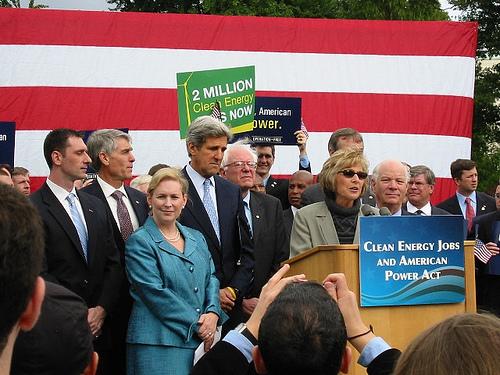 Sen. Boxer speaking at a CEJAPA rally at the Capitol Building in Washington, DC. Photo courtesy The Sierra Club via Flickr At close to 11pm Eastern, Boxer’s office has finally released the chairman’s mark of the Kerry-Boxer bill. This is the version of the bill that will be debated in hearings next week. Concurrently, the EPA has released its analysis of the economic impacts of the bill (PDF).
Sen. Boxer speaking at a CEJAPA rally at the Capitol Building in Washington, DC. Photo courtesy The Sierra Club via Flickr At close to 11pm Eastern, Boxer’s office has finally released the chairman’s mark of the Kerry-Boxer bill. This is the version of the bill that will be debated in hearings next week. Concurrently, the EPA has released its analysis of the economic impacts of the bill (PDF).
These are both crucial documents that will see a lot of discussion in coming weeks. Here’s just a few cursory notes.
The main thing to know about the EPA analysis is that it came to roughly the same conclusions as it did about the House bill, ACES. That analysis was broadly positive (see here). Here are the EPA’s four main takeaways, which it says remain unchanged between bills:
(1) the cap-and-trade policies outlined in these bills would transform the way the United States produces and uses energy; (2) the average loss in consumption per household will be relatively low, on the order of hundreds of dollars per year in the main policy case; (3) the impacts of climate policy are likely to vary comparatively little across geographic regions; and (4) what we assume about the actions of other countries has much greater implications for the overall impact of the policy than the modeled differences between the two bills. [my highlights]
So, if anyone asks you what the EPA says about the Senate clean energy bill, just say: costs are low, regional variations are small, and global climate negotiations will determine the ultimate cost. And that’s without considering the benefits — which the EPA’s analysis explicitly does not.
Since the changes between bills wouldn’t have substantial effect on the outcomes, it’s safe to assume that most of them are tweaks made either to make programs work better or to satisfy various political constituencies. More the latter, if we’re being honest.
Here, from Boxer’s office, is a summary of the changes from the House bill (ACES) to the Senate’s (CEJAPA):
Key Changes in the Chairman’s Mark
The Clean Energy Jobs and American Power Act (S. 1733)Specifies Distribution of Emissions Allowances
The Chairman’s Mark specifies the distribution of the allowances established under the Pollution Reduction and Investment program. The allocations place emphasis on investments in the following areas:• Energy Intensive and Trade Exposed industries
• Small local distribution companies (including rural electric co-operatives)
• Transportation grants
• Agriculture and forestry
• Energy Efficiency and Renewable Energy
• Advanced energy research
• Credits for early action
• Energy efficiency and renewable energy worker training
• Nuclear worker trainingNew Provisions To Address Clean Coal Technology
• The Chairman’s Mark includes new provisions to stimulate development of commercial-scale carbon capture and sequestration (CCS) technologies
• The bonus allowance program is modified to allow for advanced payments of bonus allowances for early actors with a requirement that funded projects will achieve at least a 50% reduction in greenhouse gas emissions.
• The Chairman’s Mark includes provisions that require coal fired power plants to meet emissions performance standards once sufficient commercial-scale CCS technology has been deployed, while also ensuring timely reductions in global warming pollution from coal plants.Increased Investments in Energy Efficiency and Renewable Energy
• The Chairman’s Mark increases investments in utility-scale renewable energy generation.
• The 25 percent set-aside for local governments for energy efficiency and conservation block grant continues unchanged.
• The Retrofit for Energy and Environmental Performance (REEP) program is guaranteed a share of the allocation provided to states for energy efficiency and renewable energy.
• Allowances are also dedicated to energy efficiency programs, including a specific requirement that states use some of these funds for thermal energy efficiency projects.
• Priority is given to low and moderate-income households and a dedicated portion of the energy efficiency set-aside is reserved for low-income households and for public housing retrofits.
• The Chairman’s Mark includes a new program that authorizes the EPA Administrator to provide assistance to owners and operators of buildings in the United States that implement energy efficiency measures that meet Energy Star or other relevant standards.Reducing Greenhouse Gas Emissions and Increasing Investments in the Transportation Sector
• A new allocation program with increased investments is established specifically to fund transportation projects that reduce greenhouse gas emissions. Funds are provided for the “Clean-Tea” planning and performance grants program and for Transit formula grants.
• The Clean Vehicles program is modified to place a stronger emphasis on the domestic manufacturing of advanced technology vehicles, including transit vehicles.Enhanced Agriculture and Forestry Provisions
• A more robust supplemental agriculture and forestry program is included with allocations throughout the life of the bill. The Supplemental Agriculture and Forestry Greenhouse Gas Reduction and Renewable Energy Program is strengthened to ensure measurable reductions in global warming pollution.
Directs Assistance to Rural Communities
• The Chairman’s Mark increases allowances for small electric Local Distribution Companies, including Rural Electric Cooperatives, which will benefit rural electric consumers.
• The Chairman’s Mark includes a new program to provide grants to states and non-profits to improve air quality by replacing outdated wood stoves.Promotes Advanced Renewable Fuels
• The definition of biofuels in the Renewable Fuel Standard is clarified to make clear that algae-based and other advanced fuels are included.
Enhances the Role of Tribes
• Tribes are recognized in a number of ways throughout the Chairman’s Mark. Tribes receive guaranteed allocations for the energy efficiency and renewable energy program. The Chairman’s Mark also enhances the role that Tribes will play in a number of programs in the bill.
Bigger Market Stability Reserve
• To maintain price certainty and prevent market manipulation, the size of the market stability reserve is increased in the Chairman’s Mark.
Greater Assistance for Small and Medium Refineries
• Small business refiners are given additional time to comply with the Pollution Reduction and Investment program. In addition, the domestic fuel production allowance program focuses on small and medium refineries.
We’ll have more on the bill, the EPA analysis, and the hearing that will examine them both next week.



